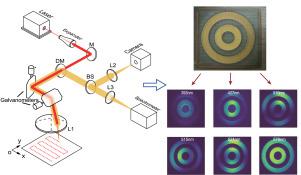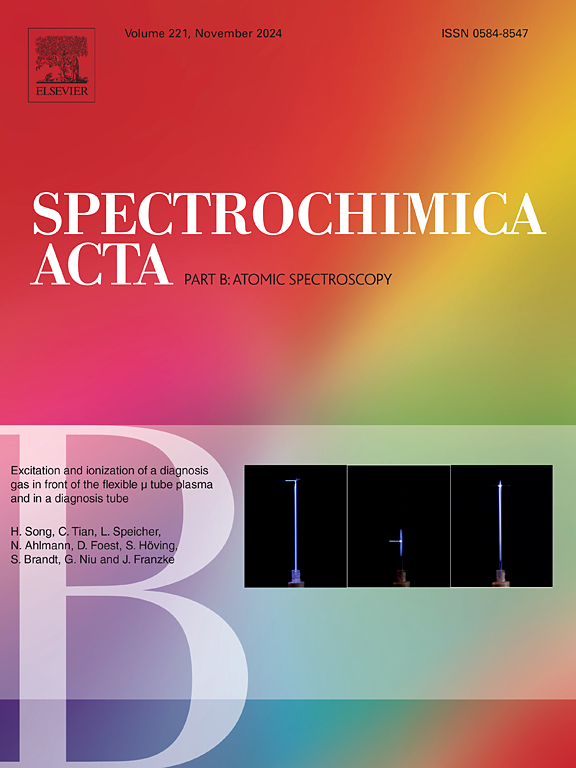基于双轴激光扫描振镜系统的无平移LIBS成像
IF 3.8
2区 化学
Q1 SPECTROSCOPY
引用次数: 0
摘要
传统的激光诱导击穿光谱(LIBS)成像系统通常依赖于机动平移台来移动样品。然而,依赖于阶段的结构在非破坏性,大面积成像方面存在局限性,特别是在原位条件下分析固定标本时。在这项工作中,我们用光束偏转方法取代了传统的样品平移方法,利用双轴激光扫描振镜系统来调节光束的偏转方向。引入远心F-theta场透镜来校正场曲率和几何畸变,使静止样品的有效扫描无需机械平移。我们应用该系统对扫描面积为32 mm×32 mm的纯铜靶和铜银复合靶进行了测量,以评价其成像性能。等离子体图像显示出明显的中心对称模式,受扫描角度的影响。此外,不同波长的光谱峰强度呈现出明显不同的分布,证明了波长依赖的相互作用机制。用干涉理论解释了这一现象,从而校正了光谱强度的空间分布。该方法为静态样品扫描系统提供了一个实用的设计框架,展示了在现场分析中可测量的应用潜力。本文章由计算机程序翻译,如有差异,请以英文原文为准。

Translation-free LIBS imaging based on a dual-axis laser scanning galvanometer system
Conventional laser-induced breakdown spectroscopy (LIBS) imaging systems typically rely on motorized translation stages to move samples. However, stage-dependent architectures have limitations in non-destructive, large-area imaging, especially when analyzing immobilized specimens under in situ conditions. In this work, we replaced the traditional sample translation method with a beam deflection approach, utilizing a dual-axis laser scanning galvanometer system to adjust the deflection direction of the light beam. A telecentric F-theta field lens was introduced to correct field curvature and geometric distortions, enabling efficient scanning of stationary samples without mechanical translation. We applied the system to measure a pure copper target and a copper–silver composite target, with a scanning area of 32 mm32 mm, to evaluate its imaging performance. The plasma images reveal a noticeable center-symmetric pattern influenced by scanning angles. Moreover, spectral peak intensities at different wavelengths show markedly distinct distributions, demonstrating the wavelength-dependent interaction mechanisms. This phenomenon was explained using interference theory, thereby enabling correction of the spatial distribution of spectral intensity. This methodology provides a practical design framework for stationary-sample scanning systems, demonstrating measurable application potential in in situ analytics.
求助全文
通过发布文献求助,成功后即可免费获取论文全文。
去求助
来源期刊
CiteScore
6.10
自引率
12.10%
发文量
173
审稿时长
81 days
期刊介绍:
Spectrochimica Acta Part B: Atomic Spectroscopy, is intended for the rapid publication of both original work and reviews in the following fields:
Atomic Emission (AES), Atomic Absorption (AAS) and Atomic Fluorescence (AFS) spectroscopy;
Mass Spectrometry (MS) for inorganic analysis covering Spark Source (SS-MS), Inductively Coupled Plasma (ICP-MS), Glow Discharge (GD-MS), and Secondary Ion Mass Spectrometry (SIMS).
Laser induced atomic spectroscopy for inorganic analysis, including non-linear optical laser spectroscopy, covering Laser Enhanced Ionization (LEI), Laser Induced Fluorescence (LIF), Resonance Ionization Spectroscopy (RIS) and Resonance Ionization Mass Spectrometry (RIMS); Laser Induced Breakdown Spectroscopy (LIBS); Cavity Ringdown Spectroscopy (CRDS), Laser Ablation Inductively Coupled Plasma Atomic Emission Spectroscopy (LA-ICP-AES) and Laser Ablation Inductively Coupled Plasma Mass Spectrometry (LA-ICP-MS).
X-ray spectrometry, X-ray Optics and Microanalysis, including X-ray fluorescence spectrometry (XRF) and related techniques, in particular Total-reflection X-ray Fluorescence Spectrometry (TXRF), and Synchrotron Radiation-excited Total reflection XRF (SR-TXRF).
Manuscripts dealing with (i) fundamentals, (ii) methodology development, (iii)instrumentation, and (iv) applications, can be submitted for publication.

 求助内容:
求助内容: 应助结果提醒方式:
应助结果提醒方式:


